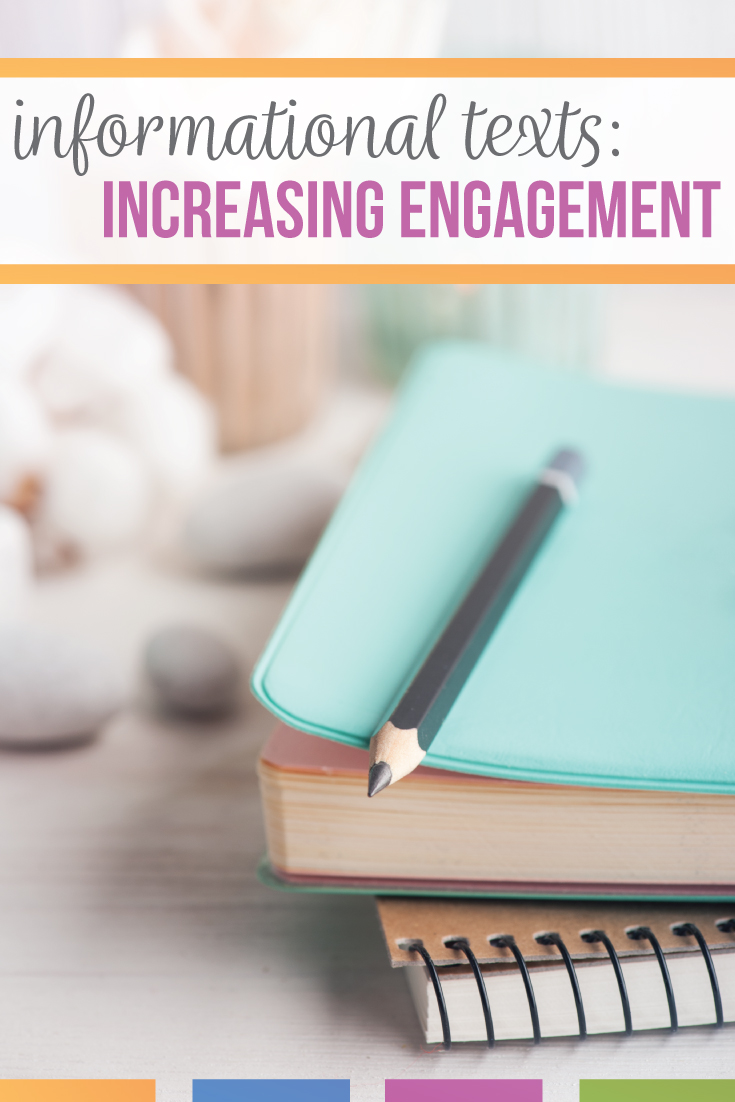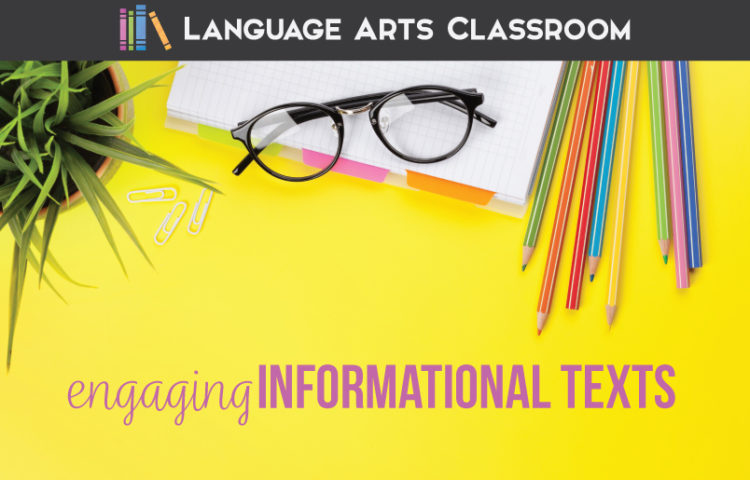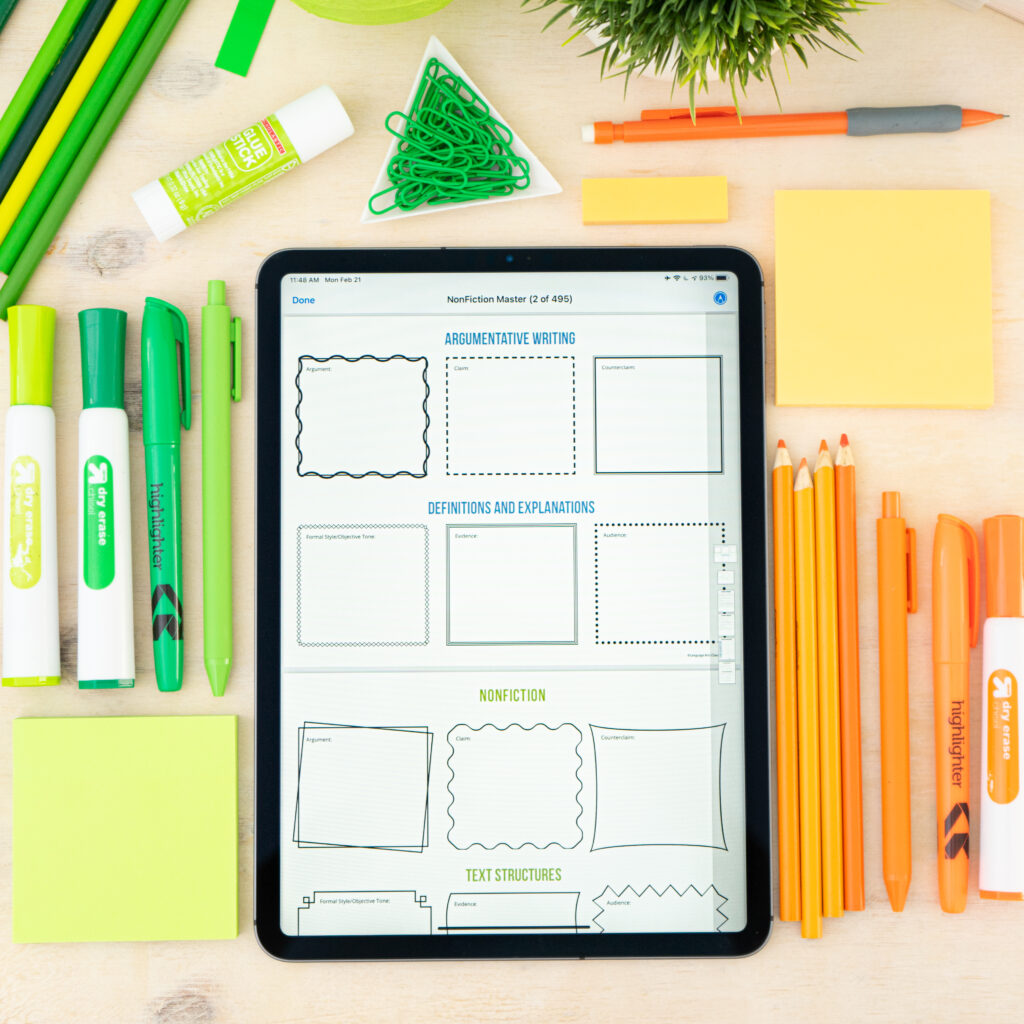Do you need informational texts and activities? Are you looking for ideas concerning how to teach informational texts? Look no more!
Don’t let informational texts seem like a “downer” in your classroom. Find texts that are meaningful to teenagers. Look for the debate presented, and allow students to research those ideas. Switch up methods of presentation!
Ok, I know what needs to happen, but I always want new ways so that students aren’t bored so that we achieve optimal learning. When I consider how to teach informational texts, I know I should account for student engagement.
Because education works best with collaboration, I asked four of my teacher-blogger friends their opinions and tricks. We developed ten ways to make informational texts work for you and your students. Together, we included informational text examples for high school and engaging informational text activities.

Bite-size chunks
Melissa from Reading and Writing Haven acknowledges that some middle and high school students appreciate nonfiction, but not most. Her advice for how to teach informational texts:
When I use informational texts with older students, I have to either find one that is of high interest, or I have to work extremely hard to make the text appealing. Either way, I’ve found it helps to teach annotation skills, to focus on close reading (but not to the extent that students hate it), and to scaffold their understanding. I begin with basic tasks, like annotating, and through close reading, we build on their initial comprehension to more of an analytical read. Asking students to read and re-read with color, like this, helps them to see the layers of their understanding in a tangible way.
These are the resources I use to break down the comprehension process into bite-size chunks for informational text units.
Comprehension
Sometimes students simply need help understanding their reading. Provide a variety of reading activities to focus students without overwhelming them. You can use these activities during and after reading. Melissa stresses that these are intended to be quick and concise ways for students to demonstrate their thinking so that teachers can gauge comprehension. You should be able to add them to any informational text unit.
Nonfiction paired with fiction
Ashley from Building Book Love confesses her love of informational text activities:
I’ve always been the oddball English teacher who finds myself reading more nonfiction than fiction. Since I gravitate to nonfiction while also adoring fiction, I find such pleasure in finding informational text pairings for my favorite pieces of literature. One of my favorite ways of pairing informational text with fiction is through podcasts. I believe podcasts open up a whole new world of “reading” for students, and I love being the one who introduces them to this growing media. For some of my favorite podcast pairing ideas, check out this post: Podcast Pairings for the Secondary ELA Classroom . Adding podcasts opens up possibilities for tons of informational text activities.
Station work
Why not? Add stations to your informational text unit!
Read nonfiction with your students, and let them reflect together. Ashley has developed these technology-based activities for stations. Students will be able to choose a meaningful way to understand the informational text.
Argumentative units
Amanda from Mud and Ink Teaching told me:
When it comes to informational texts, I’ve found the best way to integrate them into my classroom is through argumentation units. First, I work to find a juicy, debatable, relevant essential question. Then, I go off to find great articles that explore multiple sides of the issue at hand. Usually, I’ll have students jigsaw through the articles learning and teaching each other about the major claims they found. For a great pair with Romeo and Juliet, try true love or destiny. The Great Gatsby? Try what is happiness, and why is it important?
Relative to their lives
Discuss a familiar concept to students: social media.
Amanda says: From tragedy to political unrest, our world has been bombarded with events and issues worth our attention. One of the ways we’ve been sharing information, passing along condolences, and raising awareness is through what’s been nicknamed “hashtag activism.” Does this “activism” have a purpose, or are we simply adding to the masses? Let students question hashtags on social media, and relate what the informational texts to their lives.
I agree! Connection to students’ lives is a great answer for how to teach informational texts!
Cartoons
Abby from Write on with Miss G uses cartoons for informational text activities!
Abby explains: I keep informational texts engaging by diversifying the texts I use in the classroom. Close reading and analysis skills can be taught with traditional non-fiction articles, but also with political cartoons, TED Talks, documentaries, gallery walks with excerpts, and more.
In my American Dream Mini Unit for American literature, we analyze cartoons that comment on the attainability of the dream, watch portions of a documentary that explores financial inequality, and do a speed debating activity to discuss essential questions. This is our first unit of the year, so it’s great scaffolding for the more complex texts we will read throughout the course. Once students see that the elusive skill of analysis can be practiced with videos and cartoons, it’s less intimidating to analyze a formal informational text later on.
Target audience
Another factor with informational texts is that students must understand the author’s target audience. Students may not understand that they are not always the audience. As readers and writers, students must analyze audience. Abby has her students read about the legal smoking age and analyze the structure, purpose, and audience.
Balance
Lauralee from Language Arts Classroom here with free informational text examples for high school!
When I teach informational texts, I write with my students. Naturally, reading nonfiction leads to writing about the nonfiction. The biggest problem I’ve seen? Students might spend too much time summarizing rather than analyzing. Show students how to introduce a response paper and then construct a mature response. I use this free nonfiction activity to model balanced responses.
Additionally, I often write my response alongside students. Responding to informational texts in front of my students both builds relationships and models expectations.
Brain-based learning
Finally, teaching in small chunks helps students retain information, a concept I remember with all informational text activities. I use graphic organizers to organize information in my informational text unit. Sometimes, I get my students to work in centers and rotate. When students understand the information, have opportunities to reflect with each other, and involve movement, they walk away understanding the lesson.
Which. . . is what all of my friends and I (including you!) want for our students. When we build an informational text unit, we probably use a variety of techniques. We build literacy in new ways.
I’m inspired by this post to add and tweak my informational texts units. I hope that these ten ideas from popular educational bloggers spark a new method to inspire you and your students.
Would you like to join a Facebook group that will discuss how to teach informational texts? Join ELA Today for a strong community.


